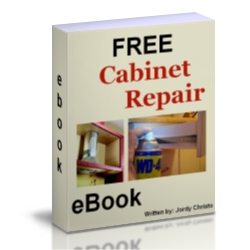Mold Removal Underneath Kitchen Bathroom Cabinets
Do you have a musty smell around a cabinet area? Mold removal may be the answer to your troubles. In locations where kitchen and bathroom cabinets have had water damage, sometimes mold will begin to form underneath the cupboards.
These suggestions do not apply to entire kitchens that have been flooded. Only do this yourself if a small area has water damage and mold is forming.
If there are large amounts of water standing under the cabinets, you should hire a professional.
Yes, you need a good mold killer and some advice on how to do this without removing the cabinetry altogether.
Before you start these steps, locate replacement materials for your toe boards. Items like plastic cabinet laminate or ¼” thick ply wood stained to match your cupboards may work.
Before starting:
The mold infested area should be isolated as close to the source as possible, so when a whole house is involved it may be necessary to section off certain areas with polyethylene sheeting, creating a containment area to prevent the spread of spores. All
standing water must be pumped out or sucked up immediately. Water damaged materials need to be dried out quickly and thoroughly before mold has time to become extensive enough to cause a total loss of the property. Water damaged sheet rock, insulation and
any other porous material that aren’t salvable need to be removed, bagged up safely in polyethylene sheeting and disposed of without spreading mold spores or other potentially harmful microorganisms to other areas.
I’d suggest eliminating the mold yourself and then hiring a professional cabinetry repair specialist to fix the places where you needed to drill holes. Have them examine the project prior to you doing the mold removal.
Follow these steps for getting rid of mold odors and potential health hazards associated with this cabinetry issue. The idea here is to bore holes in the toe base area of the cabinets.
Be sure to follow the manufactures instructions of the mold killer product you are using.
1) Drill a series of holes underneath the cabinets, in a high location, just beneath the cupboard bottoms. The holes should be about three quarters of an inch in width.
2) Using a weed killer type sprayer or insecticide style, spray the mold killer in all of the holes really well.
3) Place fans to blow air through the holes for several days, depending on the extent of the water damage.
4) Call your cabinetry specialist and have them come and repair the toe base areas that you drilled the holes into.
If your kitchen or bathroom cabinet style was manufactured with the sides of each individual cabinet extending all the way to the floor, you can remove (or. “tear out”) the toe base boards altogether. Spray the mold removal chemical designed for killing under cabinet growth and follow steps three and four above. This method is recommended if at all possible to apply to the water damaged cabinet areas.
No related posts.
Related posts brought to you by Yet Another Related Posts Plugin.




Excellent post. Really praiseworthy. Most importantly you exactly know what you are talking about. Mold is really very much dangerous for health. Its really disgusting and I am gonna try out your tips. Thanks for sharing.